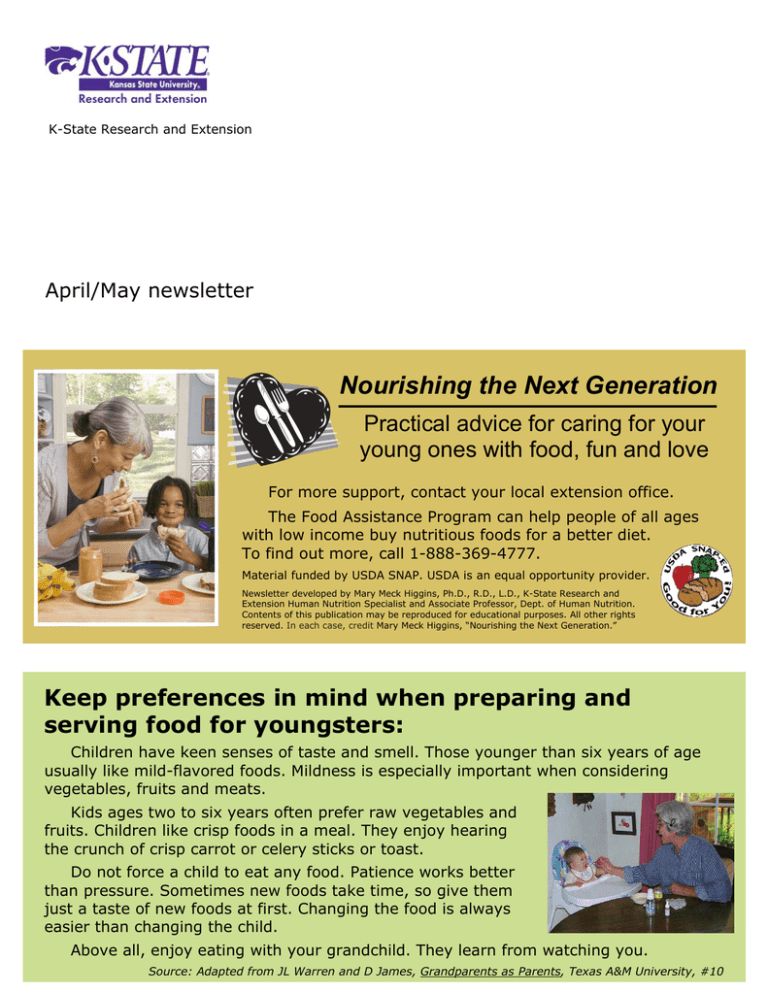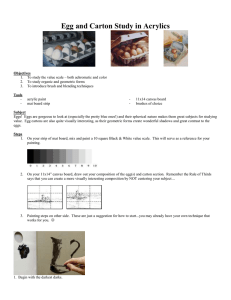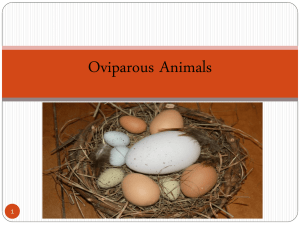Nourishing the Next Generation Practical advice for caring for your April/May newsletter
advertisement

K-State Research and Extension April/May newsletter Nourishing the Next Generation Practical advice for caring for your young ones with food, fun and love For more support, contact your local extension office. The Food Assistance Program can help people of all ages with low income buy nutritious foods for a better diet. To find out more, call 1-888-369-4777. Material funded by USDA SNAP. USDA is an equal opportunity provider. Newsletter developed by Mary Meck Higgins, Ph.D., R.D., L.D., K-State Research and Extension Human Nutrition Specialist and Associate Professor, Dept. of Human Nutrition. Contents of this publication may be reproduced for educational purposes. All other rights reserved. In each case, credit Mary Meck Higgins, “Nourishing the Next Generation.” Keep preferences in mind when preparing and serving food for youngsters: Children have keen senses of taste and smell. Those younger than six years of age usually like mild-flavored foods. Mildness is especially important when considering vegetables, fruits and meats. Kids ages two to six years often prefer raw vegetables and fruits. Children like crisp foods in a meal. They enjoy hearing the crunch of crisp carrot or celery sticks or toast. Do not force a child to eat any food. Patience works better than pressure. Sometimes new foods take time, so give them just a taste of new foods at first. Changing the food is always easier than changing the child. Above all, enjoy eating with your grandchild. They learn from watching you. Source: Adapted from JL Warren and D James, Grandparents as Parents, Texas A&M University, #10 Nourishing the Next Generation Practical advice for caring for your young ones with food, fun and love Gardening with Children and Teens Being physically active and eating one or more meals together each day offers members of “grandfamilies” a chance to benefit in some areas where they may be experiencing difficulties. One physical activity that many grandfamilies enjoy is gardening together. Growing flowers, vegetables, fruits or herbs can be refreshing way to spend time as a family. Eating and gardening with children and teens provide frequent chances for relaxed communication and strengthening emotional connections with each other. We may feel a sense of peace as we help seeds and young plants grow, and feelings of accomplishment when we harvest the bounty. Other benefits for the child include: a boost in his or her decision-making skills, confidence and self-esteem; improved math, science and language skills and general academic achievement; and decreased likelihood of risky behaviors. Overall, gardening and eating together result in more positive family and other social relationships. To help ensure a healthier future for the children that you care for, consider enjoying nature together. Start small, with a container garden near a window or on your porch, or by planting a garden in a small patch of ground in your yard. Remember Food Safety When Handling Eggs Raw eggs, poultry, ground beef and unpasteurized milk carry Salmonella germs. The Centers for Disease Control and Prevention report 40,000 illnesses from Salmonella each year, and they estimate that 30 or more times that many go unreported. Children are the most likely people to get sick from Salmonella. You can decrease the risk of illness from Salmonella when handling eggs. Here’s how: Wash hands and kitchen work surfaces with soap and water before and after handling them. Do not use eggs with cracked shells, because they could be contaminated. Eat eggs only if the yolks and whites are firm. Cook raw egg whites or yolks immediately after removing them from the shell, or within two days. Use hard-boiled eggs in the shell within a week. If the shell has been removed, use hardboiled eggs within two or three days. Decorate eggs only with a food-safe dye, such as commercial egg decorating dyes, liquid food coloring added to a water-and-vinegar mix, or food drink powders. Be careful not to crack the shells when handling them. Store eggs inside the refrigerator (not on the door shelf) before and after decorating, allowing them to be out of the refrigerator for two hours or less. If having an Easter egg hunt, it is safest to color a separate batch of eggs just for the hunt, rather than for eating. Or, color empty egg shells for the hunt. Or, use plastic eggs and put a coin in a few of them for a special treat. Have a safe and “egg-cellent” spring! Kansas State University Agricultural Experiment Station and Cooperative Extension Service, Manhattan, KS. K-State Research and Extension is an equal opportunity provider and employer. Kansas State University, County Extension Councils, Extension Districts and the U.S. Department of Agriculture Cooperating.






